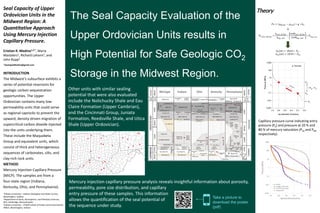Seal Capacity of Upper Ordovician Units in the Midwest Region: A Quantitative Approach Using Mercury Injection Capillary Pressure
- 1. Mercury injection capillary pressure analysis reveals insightful information about porosity, permeability, pore size distribution, and capillary entry pressure of these samples. This information allows the quantification of the seal potential of the sequence under study. Type equation here.Non-CognitivePredictorsof Student Success: A Predictive Validity Comparison Between Domestic and International Students The Seal Capacity Evaluation of the Upper Ordovician Units results in High Potential for Safe Geologic CO2 Storage in the Midwest Region. Non-CognitivePredictorsof Student Success: A Predictive Validity Comparison Between Domestic and International Students INTRODUCTION The MidwestŌĆÖs subsurface exhibits a series of potential reservoirs for geologic carbon sequestration opportunities. The Upper Ordovician contains many low- permeability units that could serve as regional caprocks to prevent the upward, density-driven migration of supercritical carbon dioxide injected into the units underlying them. These include the Maquoketa Group and equivalent units, which consist of thick and heterogeneous sequences of carbonates, silts, and clay-rich rock units. METHOD Mercury Injection Capillary Pressure (MICP). The samples are from a four-state region (Indiana, Kentucky, Ohio, and Pennsylvania). Seal Capacity of Upper Ordovician Units in the Midwest Region: A Quantitative Approach Using Mercury Injection Capillary Pressure. Cristian R. Medina1,2,*, Maria Mastalerz1, Richard Lahann1, and John Rupp3 *GeologistMedina@gmail.com Other units with similar sealing potential that were also evaluated include the Nolichucky Shale and Eau Claire Formation (Upper Cambrian), and the Cincinnati Group, Juniata Formation, Reedsville Shale, and Utica Shale (Upper Ordovician). ØæāØæź = Ø£ī ØæÅØæ¤Øæ¢ØæøØæÆ ŌłÆ Ø£ī ØÉČØæé2 ŌłŚ Øæö ŌłŚ ŌäÄ Øæź ØæāØÉČ ØÉČØæé2ŌłÆØÉĄØæ¤Øæ¢ØæøØæÆ = ØøŠ ØæÉØæ£2ŌłÆØæÅØæ¤Øæ¢ØæøØæÆ ØøŠ ØÉ╗ØæöŌłÆØæÄØæ¢Øæ¤ ŌłŚ ØæÉØæ£ØæĀØ£āØæÉØæ£2ŌłÆØæÅØæ¤Øæ¢ØæøØæÆ ØæÉØæ£ØæĀØ£ā ØÉ╗ØæöŌłÆØæÄØæ¢Øæ¤ ŌłŚ ØæāØÉČ ØÉ╗ØæöŌłÆØæÄØæ¢Øæ¤ Theory ŌäÄ0 ØæÜ = 18.63 ŌłŚ Øæā0 ; ŌäÄ20 ØæÜ = 18.93 ŌłŚ Øæā20 + Capillary pressure curve indicating entry pressure (P0) and pressure at 20 % and 80 % of mercury saturation (P20 and P80, respectively). 1Indiana University ŌĆō Indiana Geological and Water Survey, Bloomington, Indiana 2Department of Earth, Atmospheric, and Planetary Sciences, MIT, Cambridge, Massachusetts 3Indiana University ŌĆō OŌĆÖNeill School of Public and Environmental Affairs, Bloomington, Indiana Take a picture to download the poster (pdf)
- 2. Non-CognitivePredictorsof Student Success: A Predictive Validity Comparison Between Domestic and International Students Assuming 20% of pore brine displacement by supercritical CO2, the Upper Ordovician sequences can prevent upward flow from a maximum CO2 column up to 1,500 m. Non-CognitivePredictorsof Student Success: A Predictive Validity Comparison Between Domestic and International Students RESULTS: CO2-Gas Column ŌĆó Assuming 20% pore brine displacement by supercritical CO2, the Upper Ordovician sequences can prevent upward flow from a maximum CO2- column up to 1,500 m. ŌĆó Other units with similar sealing potential that were also evaluated include the Nolichucky Shale and Eau Claire Formation (Upper Cambrian), and the Cincinnati Group, Juniata Formation, Reedsville Shale, and Utica Shale (Upper Ordovician). DISCUSSION ŌĆó Local-scale evaluations at targeted injection sites should be performed to verify our results. ŌĆó Shale content from GR can be used to establish a relationship or correlation with MICO results (work in progress). Seal Capacity of Upper Ordovician Units in the Midwest Region: A Quantitative Approach Using Mercury Injection Capillary Pressure. Cristian R. Medina1,2,*, Maria Mastalerz1, Richard Lahann1, and John Rupp3 *GeologistMedina@gmail.com Calculated CO2-gas column (in meters) using P20 as value of capillary pressure.


